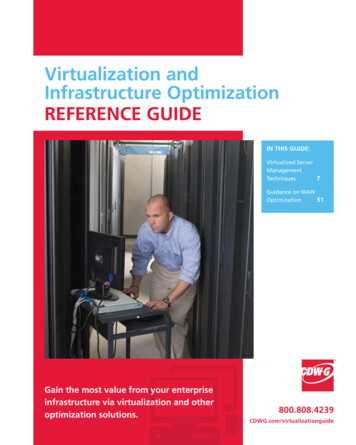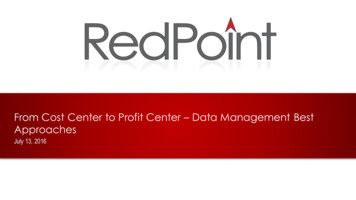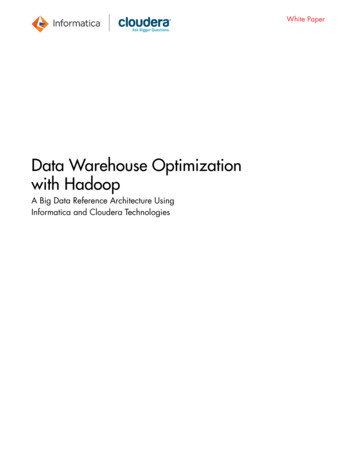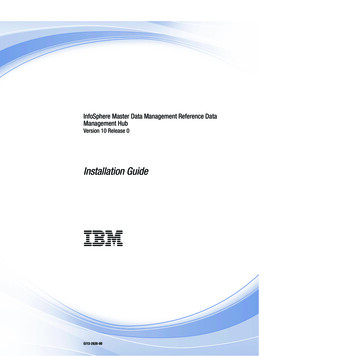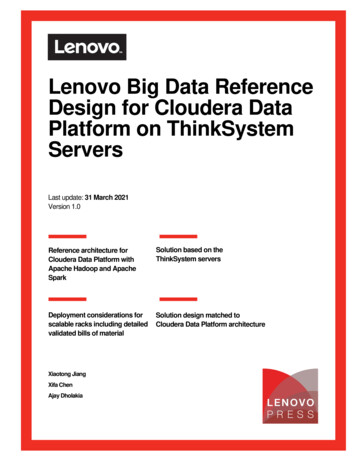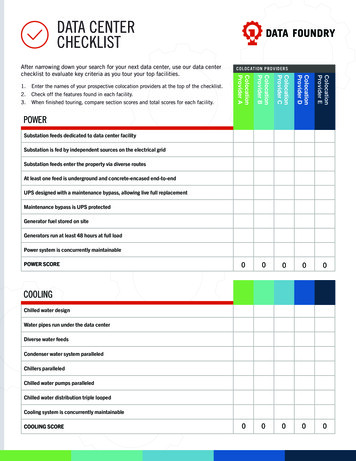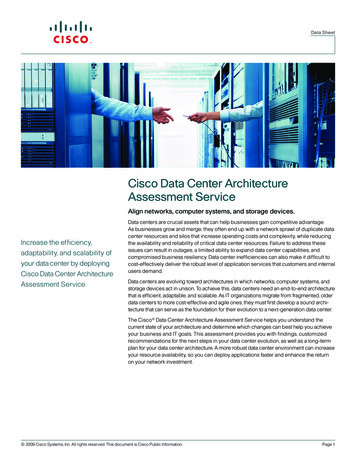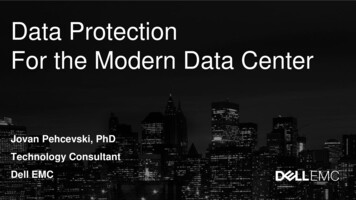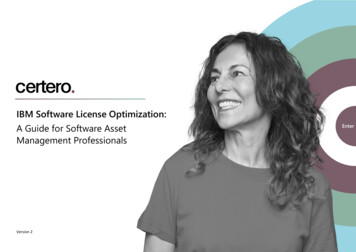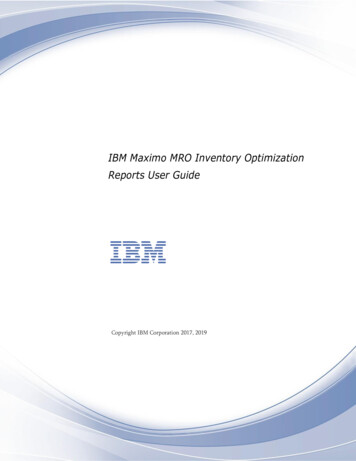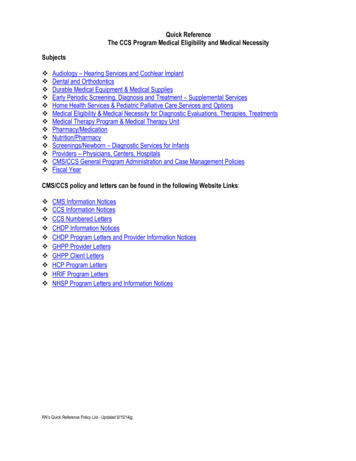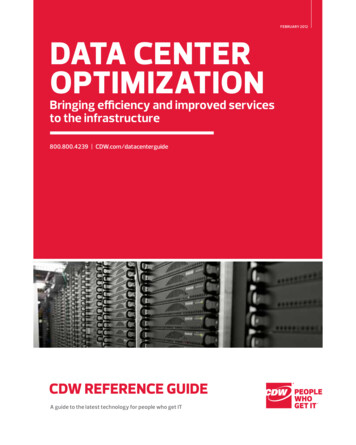
Transcription
February 2012Data CenterOptimizationBringing efficiency and improved servicesto the infrastructure800.800.4239 CDW.com/datacenterguideCDW REFERENCE GUIDEA guide to the latest technology for people who get IT
data Center optimization reference guide february 2012what’s inside:800.800.4239 CDW.com/datacenterguideChapter 1: Driving Data Center Efficiency. Strategic Improvement Optimization Gains Optimization via OrchestrationChapter 2: Optimization Strategies. Updating the Existing Data Center Data Center in a Box Reference Architectures VM MobilityChapter 3: Hardware Optimization Essentials. The Network Servers Storage Power & CoolingChapter 4: Software Essentials. Virtualization Basics Orchestration and Automation Tools Infrastructure Management ToolsChapter 5: M anagement andProcess Improvements. Management Processes Management Tools Capacity Planning Chargeback Vendor 5Glossary.Visit CDW.com/datacenterfor more information onoptimizing The data center.What is a CDW Reference Guide?At CDW, we’re committed to getting you everything you need to make the right purchasing decisions — from products andservices to information about the latest technology.Our Reference Guides are designed to provide you with an in-depth look at topics that relate directly to the IT challenges youface. Consider them an extension of your account manager’s knowledge and expertise. We hope you find this guide to be auseful resource.2
chapter 1Strategic ImprovementOptimization GainsOptimization via OrchestrationDriving Data CenterEfficiencyWhat’s driving data center optimization and whyorganizations need to plan for it.Powerful operations, technology andeconomic forces have converged todrive change in enterprise data centers.From an operational standpoint,organizational leadership has cometo view the data center as more thana factory-like utility that collectsand processes information. Topmanagement understands the value ofdata that’s available in real time to helpinform and shape decision-making. Theyalso expect the data center to be theenabler of new, rapidly deployed, publicfacing and internal user applications.From a technology standpoint,today’s data center must supportmobility, provisioning on demand,scalability, virtualization and theflexibility to respond to fastchanging operational situations.From an economic standpoint, afew years of strained fiscal conditionshave imposed tight budgets on ITorganizations in both the public andprivate sectors. That’s helped bringnew thinking to data center designand management. Organizations mustdeliver maximum output for every dollarinvested in IT. They also face pressureto reduce power use as a componentof overall organizational strategiesfor reducing their carbon footprint.Strategic ImprovementThese three converging forcesfoster an exciting but challengingapproach to data centers. In themainframe days, IT groups addedprocessors, storage or operatingsystem upgrades as demand required.But in reality, operational needsfluctuate. Projects come and go. Thecycle of application developmentquickens. The processing loads nowmust scale up and down much morequickly than in the batch processingera. The result? CIOs must find waysto support mobile users, partners andcustomers with speed and agility.And they’ve got to do it all withintight budget constraints and, inmany cases, even static budgets.How can organizations dial uptheir data center operations and fuel3
chapter 1Key Elements of an Optimization StrategyThe efficient use ofphysical spaceThis often takes the form of consolidation. Consolidation encompasses not just large,glass-house facilities, but also small server clusters and wiring closets. If there aretoo many data centers (no matter their size) supporting the organization, they addunnecessary cost, chip away at manageability and lead to power inefficiencies. Plussmall “vampire” facilities that suck power needlessly tie up inventory and cash thatcould be pumped back into the IT organization.Maximum server efficiencythrough the virtualizationof applications and relateddata resourcesVirtualization is fast spreading to individual users and their personal resources. Itsbenefits extend beyond merely improving the efficiency and usage ratio for centralservers and storage systems. They also include faster provisioning of new projects,applications or users, as well as greater reliability and business continuity thanksto fast replication of virtual machines as backups.Utilizing external cloudcomputing (where itmakes sense)A growing number of organizations have begun migrating select applications(principally e-mail and other utilitarian functions) to cloud environments run by thirdparties. That frees up staff and infrastructure for more mission-focused work suchas application development.Deploying internal clouds (whenit can provide flexibility)To support a wide range of users and services with easy scalability and rapidprovisioning, many organizations have launched their own cloud computinginfrastructures. Internal cloud strategies force a rethinking of hardwarearchitectures, utilizing consolidated, converged or data-center-in-a-boxapproaches.Optimized power useNew form factors, principally blade servers and converged infrastructures, need upto-date cooling strategies. Rather than simply chilling the interior of an entire facility,the latest cooling technologies now focus concentrated cooling where and whenit is specifically needed within racks and aisles to radically reduce cooling costs.Maximize the use ofstorage and networkingEnd-to-end enterprise data architectures require rethinking the long-held strategyof continuously adding expensive disk storage to take on new loads. Instead, ITorganizations now must update networking protocols and architectures to make themost use of bandwidth and capacity. This will more tightly weave together theorganization’s data infrastructure.reinvestment in their backbone IT assets? By pursuinga strategy of optimization. More than a fixed endstate, optimization requires continuous assessmentand planning for each element in the data center:hardware, software and supporting infrastructure.The goal of optimization is the creation of a datautility that fully supports the organization’s operationalgoals at the lowest possible cost. The process ofoptimization therefore is holistic and continuous.4Optimization GainsAlthough the paths to data center optimization aremany, the benefits that organizations gain fall into threechief categories:1. Lower costs and greater return on investment (ROI)for IT dollars2. I mproved infrastructure performance3. M ore operational value from the technology in theform of agility, flexibility and fast response to change
CDW.com/datacenterguide 800.800.4239Simply put, the more space and time that data centers takeup, the more dollars they consume. With careful planning,optimization leads to consolidation, a smaller energy footprintand more efficient use of the computing infrastructure.For example, by consolidating storage from dedicated,stand-alone subsystems to a single storage area network(SAN), the organization gains improved manageabilityand faster performance — and it saves space. The sameholds true for server virtualization, which can reduce thenumber of needed physical servers by up to 80 percent.Performance and business continuity also flowfrom data center optimization. The two are related:Applications optimized for consolidated hardwareplatforms yield more uptime, faster responses and greaterpredictability through load balancing, data caching andTransmission Control Protocol (TCP) processing.Better business continuity accrues not simply from morereliable failover and cybersecurity, but also from constant andpredictable performance available to users and customers.Data center optimization also helps organizations realizea better return on their IT investments. For example,internal clouds offer constituents (departments andusers within the organization) the kind of agility theyneed to respond to fluctuating demand. The cloud ownergains efficiency through higher and more consistentutilization rates and ease of centralized management.The organization also optimizes its power coststhrough virtualization. The marginal increase in powerconsumed by a given server running at a high use ratecomes in lower than the power used by two low-userate servers — then multiply those savings by hundreds,sometimes even thousands, of virtual machines.In short, optimization frees resources from infrastructureoperations and maintenance and makes them availableto help drive innovation and operational value.architectures, cooling and utility management, and automaticserver provisioning apply as well to blade infrastructuresthat support individual users on whatever thin client ormobile devices the organization chooses to support.But optimizing the output of the data center to meet specificservice levels requires a technique called orchestration.Orchestration tools act as master controllers of subordinatetools that, for their part, operate and optimize various piecesof the technology infrastructure. For example, one productmight control the allocation of memory and storage amongapplications. Another might manage network bandwidth.Orchestration automates and speeds up the configurationof resources to meet service level needs defined bythe organization. Optimization via Orchestration Revamped raised flooring that accommodates not onlytraditional wiring, but also works as a plenum for air exchangein cooling systems (Plus, flooring must be able to support theconcentrated weight of multiblade racks. Older data centerdesigns planned for more distributed weight.)Organizations under pressure because of IT infrastructurecosts discover that the consolidation of data centers occursnaturally as a result of optimization, not the other way around.Several tools and techniques have made their way intooptimization efforts in recent years. But fundamentally, thestate of the art in optimization encompasses not just toolsand techniques, but also a primary goal of providing excellentIT services to the organization’s functional components.Server consolidation via virtualization has becomethe de facto technology in optimization efforts. Clientvirtualization comes in as the next logical step behindserver virtualization. Lessons learned from hardwareIs Your BuildingReady?Data centers built in the 1970s on up to the 1990s might bebig enough in square footage to support today’s optimizeddata centers. But facilities for mainframe and client-serverfarms might not be right in other respects for the virtualized,agile, flexible and service-oriented data centers of today.An organization might need to rebuild (or build) a whole newhousing for its optimized data center.Experts say a modern facility would do well to have in place(or plan to acquire) the following characteristics: Scalable electrical services that can change to match theblade and storage pool densities in the data center Targeted lighting systems support the ability to readinformation on components from both sides of a rack andcan automatically dim and then switch on and off to maximizepower usage (The standard fluorescent panels in the droppedceilings of yesteryear are inadequate in an optimizeddata center.)5
chapter 2Updating the Existing Data CenterData Center in a BoxReference ArchitecturesVM MobilityOptimization StrategiesHow to get the data center to its desired stateKeeping data center optimization alignedwith the organization’s mission and goalsmeans that the management team andthe IT group must plan strategically.Optimization planning can be thoughtof as a three-legged stool that balancescapacity, cost and service-level needs: or basic capacity, there must be a path Ftoward sufficient storage, bandwidth,servers, real estate and utilities —not to mention people and skills. or rational costs, there must be Fa strategy for automation andmanagement tools that allow IT toproductively control the infrastructure. T o meet service-level requirements,the organization needs an overallplan for continuously optimizing itsinfrastructure, applications and tools.Optimization really begins before an ITengineer pulls a single cable. It starts withanalysis. That’s a top-down, bottom-upteam effort. Data center planning startswith an inventory of the current situation,including not merely physical assets andspeeds-and-feeds, but also the utilizationrate of each and every component.6What follows are three basic strategies for moving theorganization toward a service-oriented data center.Updating the Existing Data CenterOptimization of an existing data infrastructuremeans identifying each component and analyzing howit can be made more efficient. For many organizations,optimization involves consolidating two, three or moredata centers to reduce costs and simplify management.It’s possible to accomplish basic consolidationwith a simplified merger approach. But simplysqueezing two inefficient facilities into one limitssavings and fails to achieve the agility and flexibilityneeded for a service-centered approach.That’s why consolidation works best in tandem withvirtualization. Server virtualization not only reducesphysical servers but also enables dynamic reallocation ofserver capacity. Organizations pursuing cloud computingenvironments need capacity on demand. Virtualization, theamassing of multiple systems in virtual containers on singlephysical servers, is a cost-effective way to achieve this.Obvio
Data center optimization also helps organizations realize a better return on their IT investments. For example, internal clouds offer constituents (departments and users within the organization) the kind of agility they need to respond to fluctuating demand. The cloud owner gains efficiency through higher and more consistent utilization rates and ease of centralized management. The .
